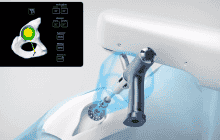
One of the most rewarding things to look forward to after hip replacement surgery is regaining mobility and independence that were previously compromised by an arthritic hip. In addition to getting adequate rest and managing your post-operative pain, the road to recovery following a total hip replacement includes light exercise and physical therapy techniques that will aid you in recovering from surgery. Your participation in the healing process is important to the long-term success of your hip replacement.
Exercises performed after surgery
Very soon after surgery it will be possible to stand and put some of your weight on your replaced hip. The nurses in the hospital will teach you how to properly position your new hip while in bed or moving about, and give you guidelines for how much weight you can put on your new hip in the early stages of recovery. Getting started with proper walking is the best way to help your hip recover from surgery and keep blood clots from forming in your leg veins.1 At first, you’ll use a walker or crutches with assistance from the medical personnel in the hospital. As you start walking, try to walk as smoothly as you can. As your muscle strength and endurance improve, your coordination will improve and you will be able to spend more time walking.
While still in the hospital, your nurses will make sure you can do the basics of personal maintenance such as walk with an aid (walker or crutches) to the bathroom, stand for short periods at the sink, and go up and down a few stairs. In some situations, a physical therapist may work with you on various exercises designed to strengthen, promote healing and increase the range of motion of your new hip. While you lie in bed you can pedal your feet and gently move your ankles back and forth to promote healing blood flow in your legs.1
Before you leave the hospital, you’ll need to meet a few basic goals. These include walking independently with a walker or crutches, walk up and down a few stairs with crutches, get into and out of a chair and bed by yourself, use the bathroom by yourself, and dress yourself.
Exercises and therapy practiced at home
Printed material illustrating exercises you can do while you are recovering from surgery will be given to you by your surgeon. You may also be visited by a rehabilitation therapist who will see that you are doing your recovery exercises properly and safely. It’s important to make a commitment to yourself to do the prescribed exercises as long as they do not cause you pain or create additional swelling. The key to remember is don’t over do it. Healing is a gradual process, and overworking your still-healing muscles and tissues can do more harm than good. Let your body tell you how much effort is good enough for you.
Common recovery exercises 2
- Slow Ankle Pumps
- Gentle Ankle Rotations
- Bed-Supported Knee Bends
- Buttock Contraction, Hold & Release
- Lying Down Straight Leg Raise, Hold & Return
Advanced exercises and activities 2
Elastic tube exercises are a popular method to increase strength in your hip muscles when you are past the early stages of recovery. These exercises involve one end of a length of elastic tubing wrapped around the ankle of your operated leg and the opposite end of the tubing attached to a stationary object such as a locked door or heavy furniture. You’ll hold on to the back of a chair for balance. The exercises introduce resistive motion to your healing hip muscles that will help make them stronger and more stable.
Even as you begin to feel better, your surgeon will advise you to avoid certain hip movements during the first few months of recovery. Before your muscle strength has returned, certain movements will still create risk of dislocation of the new hip joint.
During rehabilitation you can expect to have some good days and some bad days, but you should notice improvement and a gradual increase in your endurance over the weeks and months after your surgery. You will experience pain and swelling during your recovery and this can be managed by elevating your leg and applying ice wrapped in a towel, and taking your pain medications as prescribed. If you get more pain after exercising, it is better to cut back on the activity rather than take extra pain medication. Eventually, you’ll be able to do more activity with less pain.
Hedge your bets for success
Staying active, even beyond your home exercise program, will help hasten your recovery. But these activities should never be done to the point where it causes more pain. After the first few weeks of recovery are completed, you’ll be able to do some light walking and possibly a few turns on an exercise bicycle. After about 8 weeks, normal walking, swimming, cycling, and gentle aerobics-style exercises may be possible for you. However, activities such as jogging or running, sports that involve jumping, contact sports, and heavy lifting, should in all cases be avoided.3
Remember to follow your orthopedic surgeon’s instructions and take care to protect your new hip replacement and your general health. These are the most important ways you can contribute to the success of your recovery from total hip replacement surgery.
Sources
- American Academy of Orthopaedic Surgeons, “Activities After Hip Replacement” http://orthoinfo.aaos.org/topic.cfm?topic=a00356
- American Academy of Orthopaedic Surgeons, “Total Hip Replacement Exercise Guide” http://orthoinfo.aaos.org/topic.cfm?topic=a00303
- Beth Israel Deaconess Medical Center “Activities After Hip Replacement” http://www.bidmc.org/YourHealth/BIDMCInteractive/HealthyIs/BonesandJoints/Hip/ActivitiesAfterHipReplacement.aspx
Filed Under: Hip ReplacementRecovering from Hip Replacement





